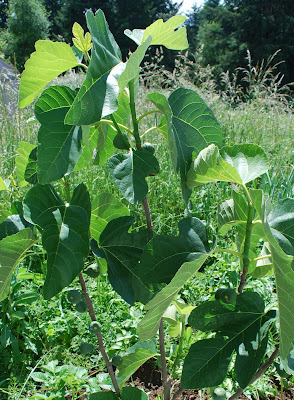 |
| Brunswick Fig Breba Crop. 5.20.16 |
Fig brebas are getting big. Brebas are figs that grow from buds on last summer's stems, and ripen during this summer. Figs that grow on this year's stems are called Main Crop, and ripen in the fall.
Some fig trees are mainly breba producers, some are mainly main crop, some are both.
The Battleground fig trees are 3 to 5 years old, except for
Brunswick which I moved there 4 years ago, and was 10 years old at the time.
Brunswick rarely has brebas, and is one of the sweetest figs, so the handful this year is great.
Brunswick goes by other names -
Dalmation,
Madonna,
Castle Kennedy,
Magnolia,
Kennedy,
Clémentine. Ancient varieties often go by many names, because they have been taken from place to place, and people who forgot the original name gave them new names. Later, they are found to be the same variety, but many people then know them by other names. Brunswick's place in the Pacific NW is tenuous - there are other fig trees that bear more figs, are more reliable, and that have most before the fall rainy season, which makes the last figs on this tree moldy. But when it bears, the figs are so amazingly sweet, juicy, and "fig flavored".
 |
| Brunswick Fig Tree, moved Dec 2012 |
 |
| Carini Fig Breba Crop. 5.20.16 |
 |
| White Marseilles / Lattarula Fig Breba Crop. 5.20.16 |
I moved this tree to Battleground as an experiment. I didn't know if it would survive. Now, after more than 3 years, it has increased a little in size, and growing many new shoots from the base. I will let the largest of those shoots grow, since they seem more vigorous than the top.
 |
| LSU Tiger Fig Tree. 5.20.16 |
Other fig trees with brebas this year:
Big breba crop:
Lattarula - also called
White Marseilles and
Italian honey Fig. Both the big original tree and the smaller tree grown from cutting and planted at Battleground, are covered with figs.
This is an old variety - Thomas Jefferson was enthusiastic about White Marseilles fig.
King - also called "
Desert King" - only the one at the old place. The cutting at Battleground is slow to establish. I expect it to need a few more years. Once established, this tree grows huge for a fruit tree. The tree at the old place is covered with breba figs.
Carini - a NOID from a Fig Forum member. Really should have a place in the Pacific NW. Generous sized figs, reddish coloration, sweet, vigorous, and bears a lot at a young age. Probably comparable to Lattarula, which is one of the best.
Fig trees with only a few brebas -
Petite negri - worth it for the fall figs. Usually has a few brebas.
Hardy Chicago - rarely has brebas but is among the first of the Main Crop summer figs. The few brebas it has, usually fall off.
No brebas at all:
Sal's fig - usually has a main crop, but the tree is not thriving at all, much smaller than any of the other, similar range in size as Petite negri but the figs are not as good. Very hardy even in our coldest winter, but I am thinking about replacing it with Celeste, when that cutting reaches a bigger size, maybe Spring 2017.
LSU Tiger - Modern fig tree from Louisiana, very big juicy figs, bears well, very vigorous, but not brebas this year. Hardiness here not known, last winter was so mild it wasn't a good test.
Smith Fig - an old Louisiana variety. May not be hardy here. I planted outside last summer, survived the mild winter. No figs yet this year. Not fertilizing because I want the growth to be tough for next winter.
Champagne Fig - a modern Louisiana variety. The figs are nice, sprightly yellow figs, small. I don't know the hardiness here and no brebas this year. Not fertilizing, as for Smith.
Dominick's Fig - a heritage variety from a fig forum member in the Eastern seaboard. I have two, one might become the rootstock for Petite negri. Haven't tasted from this tree yet.
Atreano - this might have had some if not for deer. I did not protect it well. Considered good for Pacific NW.
Other than a NOID - I'm thinking was labeled as "Sicilian white" but the label is lost so not sure, very young with 2 brebas on it's skinny stem, and Celeste - grew from cutting too late last year to get much growth, still in container for this year - I think that's all of my fig trees.
Where there is vigorous top growth, I have been snapping off the terminal leaf, leaving 5 or 6 leaves per shoot. Tipping the shoot is thought to stimulate earlier and/or better production of main crop figs, and that is also my experience. I am not doing that for the smaller Battleground fig trees, because I want them to get in as much good growth this year as possible. I did tip the strongest growth on Brunswick, Lattarula, and LSU Tiger.

